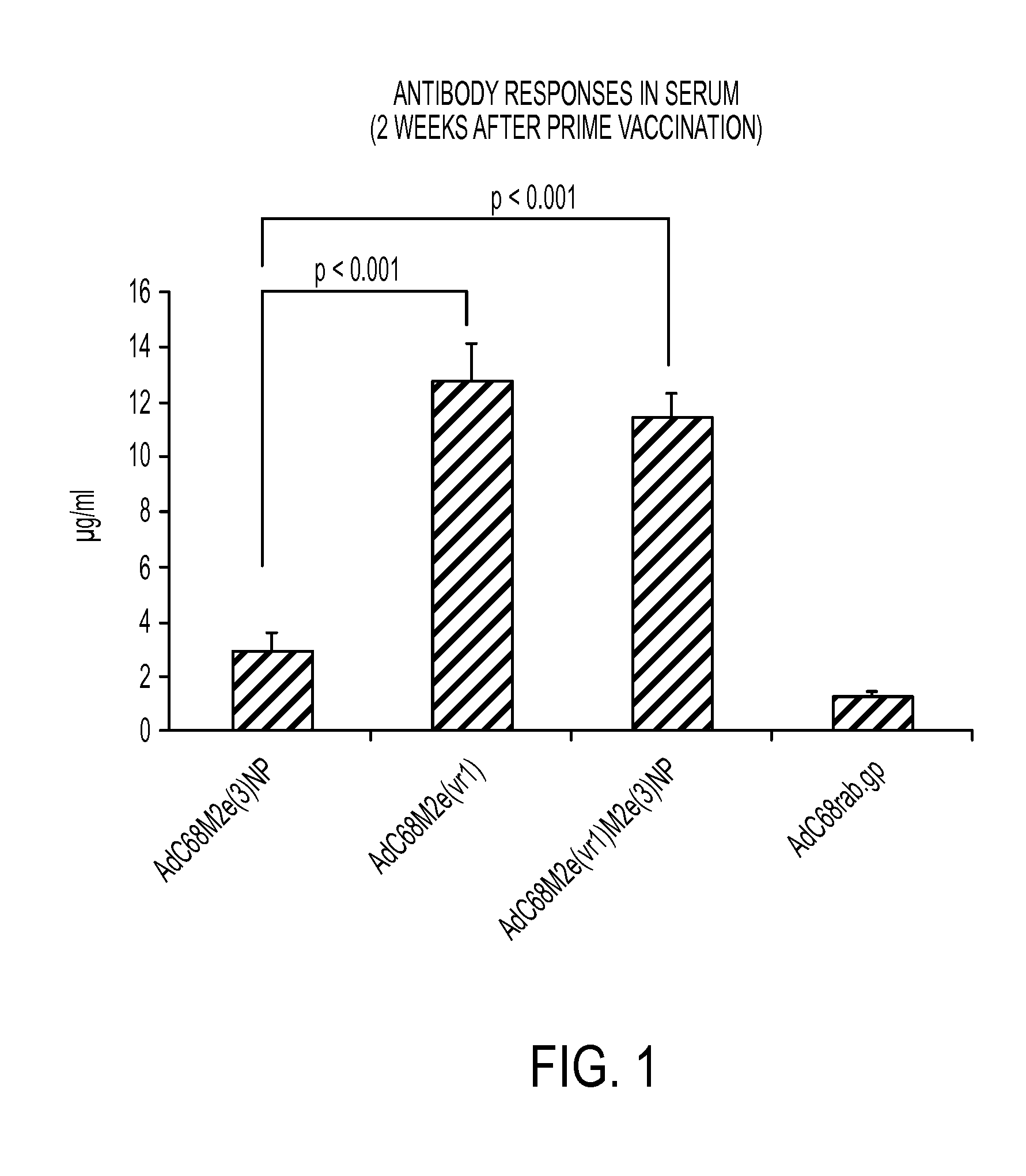Influenza vaccines containing modified adenovirus vectors
a technology of adenovirus and adenovirus, which is applied in the field of influenza vaccines containing modified adenovirus vectors, can solve the problems of global pandemic, limited protection of influenza vaccines, and reduced vaccine efficacy
- Summary
- Abstract
- Description
- Claims
- Application Information
AI Technical Summary
Benefits of technology
Problems solved by technology
Method used
Image
Examples
example 1
Construction and In Vitro Screening of Vectors
[0037]1.1. Construction and Quality Control of Vectors
[0038]AdC6 and AdC68 vectors that carry the M2e sequence within the viral hexon can be prepared using standard techniques. Modifications of the Ad hexon are carried out using standard cloning methods and sequence verification, followed by insertion of an expression cassette into E1 and verification by Southern Blotting or sequencing. Placing of the M2e epitope into the hexon of AdC68 was guided by a crystal structure available for this molecule. AdC6 belongs to the same serotype and, but for variable regions, has a high degree of sequence homology to AdC68, which permits identification of R1 (referred to in Ser. No. 61 / 488,904 as “VR1”) as shown below in the comparison of the hexon sequences of R1 (referred to in Ser. No. 61 / 488,904 as “VR1”) and its flanking regions for AdC6 and AdC68. R1 (referred to in Ser. No. 61 / 488,904 as “Vr1”) is bolded, and the insertion site within AdC68 hex...
example 2
Immunogenicity and Efficacy of Vectors in Young Mice
[0059]Immunogenicity is assessed in groups of young (6-8 week old) C57Bl / 6 mice (group size: 8 mice each). The prototype AdC68-3M2eNP and AdC6-3M2eNP vectors (referred to in Ser. No. 61 / 488,904 as “AdC68M2e(3)NP and AdC6M2e(3)NP vectors,” respectively) without hexon modifications have been tested extensively and are used for comparison.
[0060]2.1. Immunogenicity in Naïve Mice
[0061]The 4 vectors, i.e., AdC68-3M2eNP and AdC6-3M2eNP (referred to in Ser. No. 61 / 488,904 as “AdC68M2e(3)NP and AdC6M2e(3)NP vectors,” respectively) with and without the hexon modification are tested in a dose escalation experiment in which 8 young mice are injected with 108, 109, or 1010 vp of vector given intramuscularly. Vectors expressing an unrelated antigen, i.e., glycoprotein of rabies virus are used as negative controls. Mice are bled 2, 4 and 8 weeks after immunization.
[0062]Peripheral blood mononuclear cells (PBMC) are isolated and tested for frequen...
example 3
Vaccine Efficacy in Larger Animals
[0077]Ferrets are highly susceptible to human strains of influenza virus and are viewed as a suitable pre-clinical model for influenza virus infection. An additional model is a nonhuman primate challenge model. The ferret study, which uses a contemporary H1N1 virus, is used at biosafety level 2; the virus for challenge of nonhuman primates, a highly pathogenic H5N1 virus, is conducted at biosafety level 3+ approved by CDC and USDA.
[0078]3.1. Ferret Model
[0079]Young ferrets (n=6) are vaccinated as described above. An additional 6 control animals are vaccinated with AdC vectors expressing the rabies virus glycoprotein. Vaccines are given at 1010 vp i.m. In case of a prime-boost regimen, animals are primed and the boosted. Timing between prime and boost is determined based on results from mouse studies. Sera are monitored in 2 week-intervals for antibodies to M2e. As a positive control, 6 additional ferrets are vaccinated with 1 / 10th of the human dose ...
PUM
| Property | Measurement | Unit |
|---|---|---|
| Immunogenicity | aaaaa | aaaaa |
| Strain point | aaaaa | aaaaa |
Abstract
Description
Claims
Application Information
 Login to View More
Login to View More - R&D
- Intellectual Property
- Life Sciences
- Materials
- Tech Scout
- Unparalleled Data Quality
- Higher Quality Content
- 60% Fewer Hallucinations
Browse by: Latest US Patents, China's latest patents, Technical Efficacy Thesaurus, Application Domain, Technology Topic, Popular Technical Reports.
© 2025 PatSnap. All rights reserved.Legal|Privacy policy|Modern Slavery Act Transparency Statement|Sitemap|About US| Contact US: help@patsnap.com



